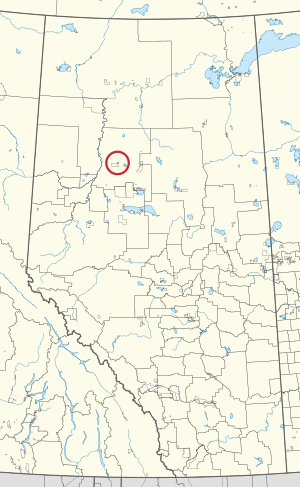Woodland Cree 227 facts for kids
Quick facts for kids
Woodland Cree 227
|
|
|---|---|
| Woodland Cree Indian Reserve No. 227 | |

Location in Alberta
|
|
| First Nation | Woodland Cree |
| Treaty | 8 |
| Country | Canada |
| Province | Alberta |
| Municipal district | Northern Sunrise |
| Area | |
| • Total | 660 ha (1,630 acre) |
Woodland Cree 227 is a special area of land in Alberta, Canada. It is known as an Indian reserve, which is land set aside for a First Nation community. This particular reserve belongs to the Woodland Cree First Nation. It's located about 60 kilometres northeast of a town called Peace River, within a larger area known as Northern Sunrise County.
Contents
Understanding Indian Reserves
An Indian reserve is a piece of land in Canada that is legally owned by the Canadian Crown. However, it is set aside for the use and benefit of a specific First Nation band. These lands are protected under Canadian law.
Why Reserves Were Created
Reserves were created through agreements called treaties between First Nations and the Canadian government. These treaties often involved First Nations giving up large areas of their traditional lands. In return, they received smaller pieces of land as reserves.
Life on a Reserve
Life on a reserve can be very different from living in a city or town. First Nations communities on reserves often have their own local governments. They work to keep their culture and traditions alive. Many reserves have schools, health centres, and community buildings.
The Woodland Cree First Nation
The Woodland Cree First Nation is an Indigenous group in Alberta, Canada. They are part of the larger Cree family, one of the largest Indigenous groups in North America. The Woodland Cree have a rich history and deep connection to the land.
Traditional Territory and Culture
Historically, the Woodland Cree lived by hunting, fishing, and trapping in the vast forests of northern Alberta. Their culture is closely tied to the natural world. They have traditional knowledge about plants, animals, and the environment. Storytelling, ceremonies, and traditional arts are important parts of their heritage.
Treaty 8 and Its Impact
The Woodland Cree First Nation is a signatory to Treaty 8. This treaty was signed in 1899 between the Crown and various First Nations. It covers a huge area of land in northern Alberta, British Columbia, Saskatchewan, and the Northwest Territories.
What Treaty 8 Means Today
Treaty 8 outlines certain rights and benefits for the First Nations who signed it. These include rights to hunt, fish, and trap on traditional lands. It also includes provisions for education and healthcare. The treaty is a living document that continues to shape the relationship between the Woodland Cree and the Canadian government.
Location and Geography
Woodland Cree 227 is situated in a northern part of Alberta. This area is known for its forests, rivers, and lakes. The landscape is typical of the boreal forest region.
Nearby Communities
The reserve is located northeast of Peace River. This town serves as a regional hub for many communities in the area. It provides services and supplies for residents of the surrounding region.
Natural Environment
The land around Woodland Cree 227 is home to various wildlife. This includes moose, deer, bears, and many bird species. The natural environment is very important to the Woodland Cree people. They rely on it for traditional activities and cultural practices.
Governance and Community
The Woodland Cree First Nation governs Woodland Cree 227. Like many First Nations, they have a Chief and council system. This system helps them make decisions for their community.
Role of Chief and Council
The Chief and council are elected by the community members. They are responsible for managing the reserve's affairs. This includes things like housing, education, and community programs. They also represent the First Nation in discussions with other governments.
Community Life
Life on Woodland Cree 227 focuses on community and family. People work together to support each other. Cultural events and gatherings are important for keeping traditions alive. The community strives to provide a good quality of life for its members.

